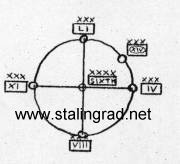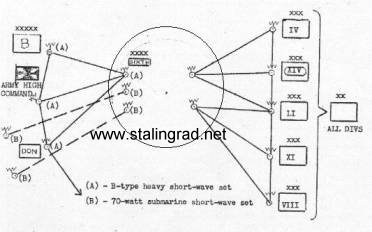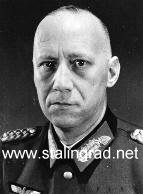|
Signal
communications in the pocket of Stalingrad and communications
with the outside.
When the Stalingrad pocket began to form (19 November), Army
headquarters was located at Golubinskaya on the Don River.
Preparations for a second headquarters (to be used during the
winter) had been made at Nizhne-Chirskaya on the Chir River.
Three lines were maintained to rear installations. One of them,
the line constructed by Army across the steppe by way of
Kachalinskiy and Kiselev to the old Army Group Don, was being
dismantled in part. The lines to the new Army Group Don
(Novocherkassk near Rostov) followed the Surovikino-Morozovsky
railroad and the Rychkov - Nizhne-Chirskaya - Morskovska
highway. These were Russian telephone lines that had been
repaired. A restored Russian cable ran along the Richkov-Kalach
highway to Peskovatka (VIII Corps);
the linking section had been constructed on the western
bank of the Don River Road. The line leading along the railroad
from Kalach to Gumrak Station via Karpovka had been repaired:
When the pocket was on the verge of being closed on November
21, Field Marshal
Paulus, on two occasions, passed through the Russian ring at
night. He was accompanied by part of his staff, including the
signal officer, with radio transmitters. The party first went to
Nizhne-Chirskaya via Peskovatka and Kalach: After a conference
with General Hoth at Nizhne-Chirskaya, Field Marshal Paulus
returned to the pocket on 23 November flying a liaison plane
over the Russian lines at an altitude of 5-12 meters. The same
airplane subsequently was to pick up the Army signal officer,
but was shot down on the return trip; the signal officer who
carried the radio codes for the encircled Army entered the
pocket two days later aboard a bomber. Meanwhile the pocket had
receded from the Don. The forces holding the western and
southern sectors prepared positions in the steppe. Toward the
end of November the pocket was approximately 40km long, and
20-30km wide. Army Headquarters was located in primitive,
splinterproof shelters near Gumrak Station. Communications into
the pocket could still be maintained via Karpovka, since the
Russian, for some strange reasons, did not cut the lines until
21 November; but on that day the line went out.
A new communications net had to be created inside the pocket. Several
Junkers aircraft arrived with spiral-four cable, A
communications net was constructed of spiral-four cable, which
linked the five corps CP’s, and was connected to Gumrak in the
center with four cables. This system provided adequate telephone
communications approximately until January.
|

|
A new communications net had to be created
inside the pocket.
|
In this set-up maintenance was very difficult, because heavy
artillery fire and constant bombing attacks caused many
breakdowns. However, these could almost invariably be repaired
quickly, since most of the telephone companies of Army and the
signal battalions of the corps were used for that purpose. As
compared to normal conditions, the maintenance service increased
approximately tenfold. I recall an instance, when one of the
repair groups performed 175 repair jobs within a 24-hour period.
Several repair shops established in bunkers were scattered
throughout the encircled area for quick and primitive repair of
cables. A substantial supply of spiral-four cable was flown in
during the first month, but additional quantities were
accidentally located in a forward depot in the pocket. When,
after the large scale Russian penetration on 10 January, the
ring of encirclement was tightened, telephone communications
failed more and more after 13 January, because the cables in the
narrow pocket were constantly destroyed by artillery fire. The
trouble shooters who had been working day and night in a
temperature of 35° C below zero, at a daily food ration of 100
grams of bread, collapsed from exhaustion. From that time on,
command over the corps and divisions in the pocket was exercised
by means of radio, primarily 5-watt equipment.
2) Radio communications
|

|
Diagram of Radio Communications,
6. Armee, 25 November 1942.
|
Radio proved to be a reliable means of communication. The Russians did
not succeed in neutralizing a large number of radio stations by
artillery
fire or
air raids. Their attempts at jamming were also unsuccessful. The
radio transmitters were dispersed in the steppe and operated in
dugouts which were kept as small as possible. In many instances
a number of vehicles, parked near these installations (for
example at Army Headquarters), invariably attracted air attacks
and thus diverted attention from the radio stations. Since Army
disposed over only one heavy B-type short-wave radio set, (the
heavy-long wave sets had not been taken into the pocket), a
70-watt short-wave transmitter, the type used in submarines, was
flown in. A second submarine radio set was to be brought in
during the month of December but could not be put into operation
because several transport planes carrying parts of the set were
shot down. The two short-wave sets at Army Headquarters, which
served as the only means of communications to the rear area were
usually overloaded, but could maintain satisfactory contact with
the outside. They used a special code which was not known to any
other German headquarters. The corps and divisions were
prohibited from communication with units outside the pocket.
Radio communications inside the pocket worked well because of the short
distances. However, until 10 January, radio was used only on a
minor scale, because telephone communications were intact up to
that date. Communication with the outside of the pocket (Army
High Command and Army Group Don) was greatly facilitated when,
after numerous unsuccessful attempts, we succeeded in
establishing voice communications with Army Group Don, and from
there by wire with the Army High Command and the Zone of the
Interior. The micro-wave transmitters which were inside the
pocket normally had a maximum range of 40km in the steppe. In
order to increase that range and bridge the distance of 110km
from the western edge of the pocket to the first German lines,
the sets had to be set up in the highest possible location. Not
far from Nizhne-Chirskaya was Hill 114 which constituted one
anchor point of our line. In order to establish our call station
as high as possible above the flat terrain of the steppe, a high
wooden structure was erected on the highest point along the
western edge of the pocket, Hill 20, almost in the front lines;
it was set up at dusk and had to be removed again before
daybreak. Twice the structure was shot to pieces, but when it
was erected for the third time we could finally use it. Toward
the end of Novomber I sent air force engineer Leucht, a
specialist in micro-wave equipment, out of the pocket by plane.
With the assistance of Army Group he set up another station on
Hill 114, and had it connected to the telephone net. On 3
December I was able to report to Field Marshal Paulus that voice
communications had been established with Army Group. A lengthy
conversation, the first one since the encirclement, took place
immediately between Field Marshal Paulus and General von
Manstein. Subsequent calls were also made to the Fuehrer
Headquarters, and to the Chief of Supply and Administration at
Morozovski. The news about the restoration of telephone
communications with the Zone of the Interior raised the morale
in the pocket to some extent. Even long-distance marriages were
performed over that line. Unfortunately, voice communications
only worked until 22 December 1942, because the German front was
withdrawn at that time, and the now very wide gap could not be
bridged any longer.
|
Born
: 20 September 1894 – Eschwege - Germany
Died
: 26 January 1986 – Hannover-Münden - Germany
Buried
: Hermannshagen Friedhof – Hannover-Münden
Germany
Entered
military service as Fahnenjunker on 26 February 1914
|

|
Military
career
Fahnenjunker
: 26 February 1914
Fähnrich
: 27 September 1914
Leutnant
: 29 January 1915
Oberleutnant
: 18 October 1918
German
Army
Hauptmann
: 1 April 1927
Major
: 1 October 1934
Oberstleutnant
: 1 April 1937
on
1 January 1943.
|
Awards
won during World War 2 :
Spange
E.K. II on 30 May 1940
Spange
E.K. I on 26 June 1940
|
|
|
|
|